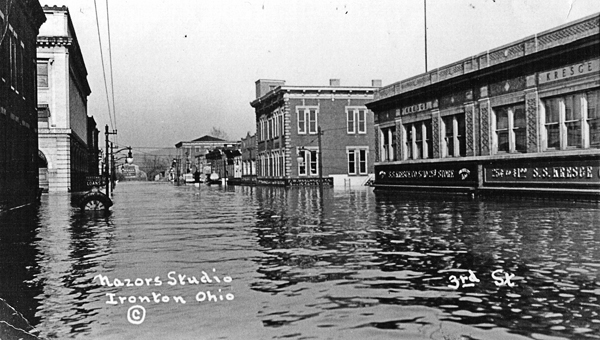As I write today’s blog post, rain pours outside my window and, though it is miles away, I know the Ohio River is rising. The rising river always brings memories of my dad.
When I was 14, Dad picked me up from school on a March Monday because we’d been released early and I had missed my bus. Dad was on his way downtown and took me with him.
I don’t remember why he went into downtown Cincinnati that day. I do remember we had dissected fish in biology class that day, and I had the lens from the fish’s eye in my purse. I’m not sure why I kept it, but it fascinated me. I told Dad about it.
After Dad had done whatever errand he had gone into the city to do, he drove down by the river. I had seen the Ohio River many times. Dad used to drive us occasionally to the public landing to watch it meander past.
We couldn’t see the public landing that March day because it was underwater, and there was no meandering. The river was in flood and rushed by, muddy and brown and carrying debris. Dad drove as close as he could get and said that as bad as this flood was, he had been through worse.
The Historic Flooding
Dad had experienced the record-breaking flood of 1937 in his hometown of Ironton, Ohio. I don’t remember all he told me about it that day. Right then, a fish lens was more interesting.
Three years later, the TV news talked about the devastating flood of 1937 on its 30-year anniversary. That day Dad told me he was listed as missing during the flood. I asked him a ton of questions and listened attentively, but didn’t think to write down his answers.
By the time I decided to write a book about the ’37 flood, Dad had been gone two decades from a heart attack. I wrote down what I could remember of what he’d told me, but there were so many pieces missing. Living in Cincinnati, I read a lot about how the ’37 flood affected folks here, but I wanted to tell Ironton’s story—Dad’s story.
Flooding My Mind with History

I went to Ironton to the library’s archives. I read accounts of the flood, one written day by day as the water rose. Another was written as a way to inform residents of Ironton what was happening in their town because newspaper offices were underwater and papers weren’t being printed. How I wished Dad were still around to fill in the gaps!
I talked to his sister, who had been 14 at the time of the flood, and whose memories were still clear and vivid.
My aunt, Margaret Ann (called Mac by much of the family, but whom Dad had affectionately called MarAnn), and I talked for hours. She answered questions and gave me tidbits of information I hadn’t even thought to ask. Every time we talked on the phone, I came away with some new nugget.
A few days after our conversations, I often received a manila envelope filled with pages of Mac’s beautiful handwriting, detailing things she had forgotten to tell me. She even sent photos.
I could not have written the novel Not on Fifth Street (Calkins Creek, 2017) without Margaret Ann’s help, but she gave me even more. In those letters filled with stories of the flood, she often went off on tangents that brought a lot of family history to life for me.
On November 2, 2018, Margaret Ann passed away at the age of 96. She had been the last surviving of my Dad’s eight siblings, and my family lost a true treasure.
Not on Fifth Street is a personal connection to the flood, to my father, to my aunt, and to my Ironton roots.
I went back to Ironton last week to visit a school and talk about the book. I love meeting students, and they enjoy hearing about a book set in their own town. A couple family members were there to hear me speak and a few adults who had their own family connections to the flood came out as well.
Writing has always been my passion, but connecting with readers is my new joy!


